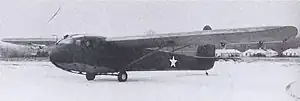| CG-3A | |
|---|---|
 | |
| Role | Military glider |
| Manufacturer | Commonwealth Aircraft, Inc. |
| Designer | Waco Aircraft Company |
| First flight | Early February 1942 |
| Primary user | United States |
| Number built | 100 |
The Waco CG-3A was a US light troop military glider of World War II.
Design and development
The CG-3A was the United States Army Air Force's first production troop-carrying glider. 300 CG-3A 9-place gliders were initially ordered, but 200 of these were cancelled. A few of the 100 built by Commonwealth Aircraft (formerly Rearwin Aircraft) were used as trainers for the improved CG-4A, but most remained in their shipping crates in storage. The production CG-3A was developed from the experimental XCG-3 which was the only one built by Waco and given Army Air Forces Serial No. 41-29617.[1]
Operational history
The CG-3A became obsolete with the development of the much improved Waco designed CG-4A 15-place glider with its alternate load of military equipment. The CG-3A did not see any combat and several were used in limited training roles.
Variants
- XCG-3 : Prototype 8-seat glider. One built 1942.[2]
- CG-3A : Production 9-seat glider. 100 built by Commonwealth Aircraft.[2]
Specifications (CG-3A)
Data from The Concise Guide to American Aircraft of World War II[3]
General characteristics
- Crew: 2
- Capacity: 7 troops
- Length: 43 ft 4 in (13.21 m)
- Wingspan: 73 ft 1 in (22.28 m)
- Empty weight: 2,044 lb (927 kg)
- Max takeoff weight: 4,400 lb (1,996 kg)
Performance
- Maximum speed: 120 mph (190 km/h, 100 kn) (under tow)
- Cruise speed: 100 mph (160 km/h, 87 kn)
- Minimum control speed: 38 mph (61 km/h, 33 kn)
See also
Aircraft of comparable role, configuration, and era
- Airspeed Horsa
- Antonov A-7
- DFS 230
- General Aircraft Hotspur
- Gribovsky G-11
- Kokusai Ku-8
- Schweizer cargo glider designs
- Slingsby Hengist
- Waco CG-4
Related lists
References
- Mondey, David (1996). The Concise Guide to American Aircraft of World War II. London: Chancellor Press. ISBN 185152 706 0.
- "Transport Gliders: The Rise and Demise of a Weapon:Part Four". Air Enthusiast. Vol. 2, no. 6. June 1972. pp. 318–322.